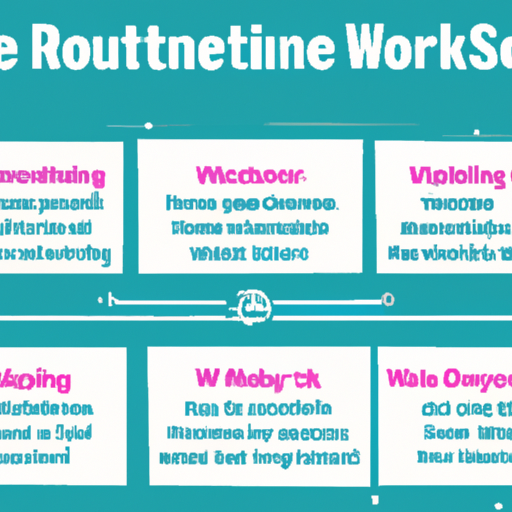If you’re looking to start a new fitness journey or revamp your current routine, having a well-structured weekly workout plan is the key to success. In this article, you’ll discover practical tips and strategies on how to plan a weekly workout routine that is both effective and sustainable. From setting realistic goals to incorporating a variety of exercises, this guide will help you create a balanced and enjoyable fitness schedule that keeps you motivated and on track towards achieving your health and fitness goals. So grab a pen and paper, and let’s get started on planning your ultimate weekly workout routine!
Understanding Personal Fitness Goals
Assessing your current fitness level
To begin planning your weekly workout routine, it is important to first assess your current fitness level. This will help you determine your starting point and identify areas that need improvement. You can do this by considering factors such as your cardiovascular endurance, muscular strength and endurance, flexibility, and body composition. Assessing your fitness level can involve performing various tests or measurements, including a cardiovascular endurance test, a strength test, a flexibility test, and a body composition assessment. This will give you a clear picture of where you currently stand and what areas you need to focus on.
Defining your fitness objectives
Once you have assessed your current fitness level, it is time to define your fitness objectives. What do you want to achieve through your workouts? Are you looking to lose weight, build muscle, improve cardiovascular endurance, enhance flexibility, or increase overall fitness? Clearly defining your fitness objectives will help you tailor your workout routine to meet your specific goals. It is important to set realistic and achievable objectives that are aligned with your current fitness level. This will keep you motivated and ensure that you are on the right track to reaching your desired outcomes.
Balancing various fitness goals
While it is important to have clear fitness objectives, it is equally important to find a balance between different fitness goals. For example, if your primary goal is to build muscle, it is still essential to include cardiovascular exercises for overall health and endurance. By incorporating a variety of exercises that target different aspects of fitness, you can achieve a well-rounded workout routine that addresses all of your needs. Balancing various fitness goals will not only help you avoid overtraining specific muscle groups but also promote overall physical well-being.
How your fitness goals affect your workout routine
Understanding how your fitness goals affect your workout routine is crucial for maximizing the effectiveness of your workouts. Different fitness goals require different workout approaches. For example, if your goal is to lose weight, your workout routine may include a combination of cardiovascular exercises and strength training to burn calories and build lean muscle mass. On the other hand, if your goal is to increase strength, your routine may focus more on heavy resistance training with fewer cardiovascular exercises. By aligning your workout routine with your specific fitness goals, you can optimize your time and efforts in the gym.
The Importance of Comprehensive Exercise
Benefits of strength training
Strength training is an essential component of a comprehensive workout routine. It not only helps build and tone muscles but also offers numerous other benefits. Resistance training increases bone density, improves joint stability, enhances metabolism, and promotes weight management. It is also beneficial for overall functional fitness, as it improves strength, power, and endurance. Incorporating strength training exercises, such as weightlifting, bodyweight exercises, or resistance band workouts, into your routine will contribute to a well-rounded fitness program.
Roles of aerobic exercise
Aerobic exercise, also known as cardiovascular exercise, plays a vital role in maintaining overall health and fitness. It improves cardiovascular endurance, strengthens the heart and lungs, and helps burn calories for weight management. Regular aerobic exercise, such as running, swimming, cycling, or dancing, can also reduce the risk of chronic diseases, including heart disease, diabetes, and certain cancers. Including aerobic exercises in your workout routine will not only benefit your cardiovascular health but also contribute to your overall fitness and well-being.
Relevance of flexibility and balance
Flexibility and balance are often overlooked aspects of fitness but are equally important for overall physical health. Flexibility exercises improve joint range of motion, prevent injuries, and enhance posture. Balance exercises, on the other hand, help prevent falls, especially among older adults, and improve stability and coordination. incorporating stretching exercises, yoga, or Pilates into your routine can help improve flexibility, while exercises like standing on one leg or using a balance board can enhance balance. Prioritizing flexibility and balance exercises will ensure a well-rounded workout routine.
Continual improvements and progressive overload
In any workout routine, it is important to continually challenge the body to make progress. This can be achieved through a principle called progressive overload. Progressive overload involves gradually increasing the demands placed on the body to promote adaptation and improvement. This can be done by increasing the intensity, duration, or frequency of your workouts. By progressing your workouts over time, you will continue to challenge your body, prevent plateauing, and achieve continual improvements in strength, endurance, and performance.

This image is property of images.unsplash.com.
Devising a Weekly Schedule
Prioritizing workout amidst busy schedule
When planning your weekly workout routine, it is important to prioritize exercise amidst your busy schedule. It can be challenging to find time for workouts, especially if you have other commitments such as work, school, or family responsibilities. However, making exercise a priority is essential for your overall health and well-being. Consider your daily schedule and identify time slots that are most suitable for fitting in your workouts. This may involve waking up earlier, utilizing lunch breaks, or dedicating specific times in the evening. Prioritizing your workouts will ensure that you make consistent progress towards your fitness goals.
How many days to workout each week
The number of days you should workout each week depends on various factors, including your fitness level, goals, and available time. The American College of Sports Medicine recommends at least 150 minutes of moderate-intensity aerobic exercise or 75 minutes of vigorous-intensity aerobic exercise per week for most adults. This can be further supplemented with two or more days of strength training exercises. However, the specific number of days may vary depending on your individual circumstances. It is important to strike a balance between allowing enough time for rest and recovery while still providing an adequate stimulus for progress.
Duration of each workout session
The duration of each workout session will depend on the type and intensity of exercises you are performing, as well as your fitness level and goals. For cardiovascular exercises, aim for at least 30 minutes of moderate-intensity activity or 15 minutes of vigorous-intensity activity. Strength training sessions typically last 45 minutes to an hour, with a focus on targeting major muscle groups. Flexibility and balance exercises can be incorporated into your routine for 10 to 15 minutes. Remember to listen to your body and gradually increase the duration as your fitness level improves.
Time best for working out
The best time for working out is ultimately a personal preference and may vary for each individual. Some people prefer to exercise in the morning to kickstart their day and boost energy levels. Others find that evening workouts help relieve stress and promote better sleep. Consider your daily routine and energy levels at different times of the day to determine when you feel most motivated and perform at your best. Whether you choose to workout in the morning, afternoon, or evening, consistency is key. Find a time that works best for you and stick to a regular schedule to establish a habit that will support your fitness goals.
Types of Workouts to Include
Resistance training workouts
Resistance training workouts, also known as strength training or weightlifting, involve using external resistance to work against the muscles. These workouts can be performed with free weights, weight machines, resistance bands, or bodyweight exercises. Including resistance training in your routine is beneficial for building muscle, increasing strength, improving bone density, and boosting metabolism. Focus on targeting all major muscle groups, such as the chest, back, shoulders, arms, legs, and core, to achieve balanced muscular development.
Cardiovascular exercises
Cardiovascular exercises, also referred to as aerobic exercises, aim to increase heart rate and breathing rate to improve cardiovascular endurance. These exercises can be performed in various forms, including running, jogging, brisk walking, cycling, swimming, dancing, or using cardiovascular machines such as treadmills or ellipticals. Cardiovascular exercises burn calories, strengthen the heart and lungs, and improve overall fitness. Aim to include at least 150 minutes of moderate-intensity aerobic exercise per week to reap the many health benefits associated with cardiovascular fitness.
Flexibility enhancing routines
Flexibility enhancing routines, such as stretching, yoga, or Pilates, help improve joint range of motion, prevent injuries, and enhance overall flexibility. Stretching exercises can be performed both dynamically (moving through stretches) and statically (holding stretches for a period of time). Yoga and Pilates incorporate a combination of stretching, strength, and balance to promote flexibility and overall mind-body wellness. Including flexibility enhancing routines in your workout routine will help maintain joint health and improve overall functional fitness.
Balance and stability workouts
Balance and stability workouts are particularly important for individuals of all ages, but especially for older adults. These exercises aim to improve proprioception, coordination, and overall balance. Balance exercises can include standing on one leg, using a balance board, or performing exercises that challenge stability, such as lunges or squats on an unstable surface. Incorporating balance and stability workouts into your routine will help prevent falls, improve posture, and enhance overall coordination and athletic performance.
Compound and isolation exercises
Compound exercises involve working multiple muscle groups simultaneously, while isolation exercises target specific muscles. Both types of exercises have their place in a well-rounded workout routine. Compound exercises, such as squats, deadlifts, bench presses, and pull-ups, provide functional strength and have a higher calorie-burning potential. Isolation exercises, such as bicep curls or calf raises, allow you to specifically target and strengthen individual muscles. Including a mix of compound and isolation exercises in your routine will ensure comprehensive muscular development.

This image is property of images.unsplash.com.
Rest and Recovery
Understanding the importance of rest days
Rest days are a crucial part of any workout routine. They allow for muscle repair and growth, prevent overtraining, and reduce the risk of injury. While it may be tempting to push yourself to the limit every day, especially when motivated, giving your body adequate time to recover is essential for long-term progress. Rest days give your muscles time to repair and adapt to the stress placed upon them during workouts. It is during rest that your fitness gains are truly made. Neglecting rest days can lead to overtraining, fatigue, decreased performance, and increased risk of injury.
How to schedule rest days
Scheduling rest days in your weekly workout routine is equally as important as planning your workout days. The frequency of rest days will depend on your fitness level, workout intensity, and overall recovery ability. It is generally recommended to have at least one or two rest days per week. However, if you are new to exercise, have intense training sessions, or feel excessively fatigued, you may need more rest days. Pay attention to your body’s signals and adjust your rest schedule accordingly to ensure optimal recovery and prevent burnout.
Impact of rest on performance
Rest is not just about physical recovery but also plays a significant role in performance improvement. When you allow your body adequate time to rest and recover, you give your muscles and other body systems the chance to repair and adapt. This can lead to increased strength, endurance, and overall fitness gains. Additionally, rest days help prevent mental burnout and allow you to maintain motivation and enthusiasm for your workouts. Embrace rest as an integral part of your workout routine and recognize its positive impact on your long-term performance.
Active recovery days
While rest days are essential, incorporating active recovery days can also be beneficial. Active recovery involves engaging in low-intensity activities that promote blood flow and aid in recovery. This can include activities such as light walking, swimming, yoga, or foam rolling. Active recovery helps reduce muscle soreness, increase circulation, and support the recovery process. By incorporating active recovery days into your routine, you can maintain physical activity while still allowing your body the necessary time to rest and recover.
Creating a Balanced Routine
Alternating muscle groups
Creating a balanced routine involves alternating muscle groups to ensure that all major muscles are adequately targeted and given sufficient rest between workouts. This approach helps prevent overtraining specific muscles while promoting overall muscular development. For example, you can schedule upper body workouts on certain days and lower body workouts on others. Additionally, incorporating full-body workouts or split routines that target different muscle groups on different days can provide a balanced approach. Alternating muscle groups not only promotes balanced strength development but also allows for optimal recovery and overall progress.
Mixing high intensity and low intensity workouts
To create a balanced workout routine, it is important to include a mix of high intensity and low intensity workouts. High intensity workouts, such as interval training or high-intensity interval training (HIIT), involve short bursts of intense exercise followed by periods of rest or low-intensity exercise. These workouts help improve cardiovascular fitness, burn calories, and challenge the body. On the other hand, low intensity workouts, such as steady-state cardio or gentle yoga, provide the body with an opportunity to recover and promote relaxation. By combining both high and low intensity workouts, you can achieve a well-rounded routine that stimulates different energy systems and maximizes overall fitness gains.
Incorporating both static and dynamic exercises
Another key aspect of creating a balanced workout routine is incorporating both static and dynamic exercises. Static exercises involve holding a position or posture without movement, while dynamic exercises involve movement through a range of motion. Both types of exercises have their own benefits and contribute to overall fitness. Static exercises, such as planks or isometric holds, help develop core stability and improve muscular endurance. Dynamic exercises, such as lunges, squats, or push-ups, promote functional strength and enhance joint mobility. Including a mix of static and dynamic exercises will ensure that you target different muscle fibers and movement patterns, leading to a well-rounded fitness program.

This image is property of images.unsplash.com.
Nutrition and Hydration
Importance of nutrition in workout effectiveness
Proper nutrition plays a crucial role in the effectiveness of your workouts. The foods you consume provide the energy and nutrients needed to fuel your workouts, repair muscle tissues, and support overall recovery. A well-balanced diet that includes a variety of whole foods, such as lean proteins, complex carbohydrates, healthy fats, and plenty of fruits and vegetables, is essential for optimal workout performance. Additionally, paying attention to pre and post-workout nutrition can help maximize your energy levels, muscle recovery, and overall results.
Appropriate pre and post-workout meals
To optimize your workouts, it is important to consume appropriate pre and post-workout meals. Pre-workout meals should provide a combination of carbohydrates for energy and protein for muscle repair. Aim to consume a meal or snack containing both carbohydrates and protein at least 1-3 hours before your workout. This can include options such as a banana with nut butter, Greek yogurt with berries, or a whole grain wrap with lean protein. Post-workout meals should focus on replenishing glycogen stores and providing protein for muscle recovery. Aim to consume a meal or snack containing carbohydrates and protein within 1-2 hours after your workout. Consider options such as a protein shake with a banana, a chicken and vegetable stir fry with brown rice, or a protein bar with a piece of fruit.
Benefits of staying hydrated
Staying hydrated is essential for optimal workout performance and overall health. Water plays a critical role in regulating body temperature, lubricating joints, supporting digestion, and transporting nutrients to cells. Dehydration can significantly impair athletic performance, lead to fatigue, and increase the risk of heat-related illnesses. It is important to drink water throughout the day to maintain proper hydration, and especially before, during, and after your workouts. Aim to consume at least 8 cups (64 ounces) of water per day, or more if you are engaging in intense exercise or live in a hot environment. Listening to your body’s thirst cues and monitoring your urine color can help ensure adequate hydration.
Supplement considerations
While proper nutrition should ideally come from whole foods, there may be instances where supplements can enhance your fitness journey. Supplements, such as protein powders, creatine, or branched-chain amino acids (BCAAs), can be used to support muscle recovery, improve performance, and fill in nutritional gaps. However, it is important to consult with a healthcare professional or registered dietitian before incorporating supplements into your routine. They can help determine which supplements, if any, may be beneficial for you based on your specific needs and goals. Additionally, remember that supplements should never replace a balanced diet and should be used as a complement to a healthy lifestyle.
Tracking Progress and Adjusting the Plan
Importance of monitoring progress
Tracking your progress is essential for evaluating the effectiveness of your workout routine and staying motivated. By monitoring your progress, you can objectively see how your body is responding to the workouts and identify areas that need improvement. There are several ways to track progress, including keeping a workout journal, taking body measurements, recording workout times or distances, or using fitness apps or wearable devices. Regularly reviewing your progress allows you to celebrate achievements, make necessary adjustments, and stay on track towards your fitness goals.
Adjusting workout intensities
As your fitness level improves, it is important to periodically adjust your workout intensities to ensure continued progress. Your body adapts to the demands placed upon it, so what once felt challenging may become easier over time. To avoid plateauing, gradually increase the difficulty, duration, or intensity of your workouts. This can involve increasing the weights you lift, adding more repetitions or sets, shortening rest periods, or incorporating more challenging variations of exercises. By continuously challenging your body, you stimulate further adaptations and maintain progress.
Changing routines to avoid plateau
In addition to adjusting workout intensities, it can be beneficial to change routines altogether to avoid plateau and keep your workouts interesting. The human body is highly adaptable, and it can reach a point where it no longer responds to the same exercises and stimuli. Changing routines not only challenges your muscles in new ways but also prevents boredom and helps to maintain motivation. Consider incorporating different exercise modalities, trying new workout classes or activities, or varying the order or structure of your workouts. By introducing variety into your routine, you can continue making progress and avoid hitting a plateau.

Incorporating a Variety of Exercises
Keeping workout interesting
One of the keys to sticking with a workout routine is to keep it interesting and enjoyable. Doing the same exercises over and over again can quickly become monotonous, leading to decreased motivation and adherence. By incorporating a variety of exercises, you can keep your workouts fresh and exciting. Try different types of cardiovascular exercises, explore new strength training exercises or equipment, or participate in group fitness classes or outdoor activities. By embracing variety, you can find joy in your workouts and maintain long-term consistency.
Trying new physical activities
In addition to incorporating variety within your routine, trying new physical activities outside of your regular workouts can further enhance your overall fitness and well-being. Engaging in activities such as hiking, swimming, rock climbing, dancing, or playing a sport not only provides additional cardiovascular exercise but also promotes skill development, social interaction, and mental stimulation. Trying new physical activities allows you to step outside your comfort zone, explore different movement patterns, and enjoy the benefits of a well-rounded active lifestyle.
Cross-training benefits
Cross-training involves participating in a variety of different activities and exercise modalities to achieve a well-rounded fitness program. Cross-training offers numerous benefits, including improved overall fitness, reduced risk of overuse injuries, enhanced muscular balance, and increased motivation. By engaging in activities that target different muscle groups and movement patterns, you can strengthen your body in different ways and minimize the risk of overtraining or burnout. Cross-training not only enhances physical fitness but also provides mental stimulation and adds diversity to your workouts.
Consideration of Individual Limitations and Needs
Working with personal health conditions
When planning a workout routine, it is crucial to take into consideration any personal health conditions or limitations you may have. Certain health conditions or injuries may require modifications or specific exercises to avoid exacerbating the condition or causing further harm. It is always advisable to consult with a healthcare professional or a qualified fitness trainer before starting or modifying any exercise program, especially if you have existing health conditions. They can provide guidance and personalized recommendations to ensure your workouts are safe and aligned with your specific needs.
Respecting the body’s limitations
Even without specific health conditions, it is important to respect your body’s limitations and avoid pushing yourself beyond what is safe and comfortable. Everyone’s body is unique, and it is essential to listen to your body’s signals and not exceed your capabilities. This includes being mindful of proper exercise form, avoiding excessive weight or intensity, and recognizing the difference between discomfort and pain. Pushing your body too hard can lead to injury and setbacks in your fitness journey. Embrace a mindset of self-care and prioritize your well-being when designing your workout routine.
Importance of professional guidance
If you are new to exercise, have specific health concerns, or simply want to optimize your workouts, seeking professional guidance can be highly beneficial. Working with a qualified fitness professional, such as a personal trainer or a registered exercise physiologist, can help ensure that your workout routine is safe, effective, and tailored to your individual needs and goals. These professionals can provide expert advice, support, and proper instruction on exercise technique, program design, and injury prevention. Investing in professional guidance can provide you with the knowledge and confidence needed to make the most out of your workouts.
In conclusion, planning a weekly workout routine involves understanding your personal fitness goals, assessing your current fitness level, and defining objectives. A comprehensive exercise routine should include strength training, aerobic exercises, flexibility and balance exercises, and progressive overload for continual improvements. Prioritizing workout amidst a busy schedule, determining the number of workout days per week, and finding the ideal workout duration and time are key considerations. Including various types of workouts, incorporating rest and recovery, creating a balanced routine, and paying attention to nutrition and hydration are crucial for optimal results. Tracking progress, adjusting the plan, incorporating a variety of exercises, and considering personal limitations and needs will further enhance your fitness journey. Finally, seeking professional guidance can provide valuable support and expertise throughout your fitness endeavors. By following these guidelines, you can create a well-planned and personalized workout routine that will lead you to achieve your fitness goals and improve your overall health and well-being.


